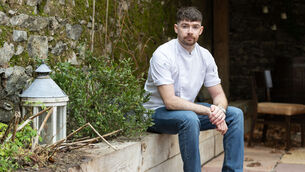Pure and simple
The rituals surrounding wedding food interests me most and some time ago I looked at the pattern of Irish wedding food in the 19th and early 20th century. What follows are some of the findings and it's clear that whatever the economic standings of the parties involved, they strove to extend generous hospitality with such flamboyant effort so as not to taint their reputation with undertones of meanness or want.
Do things ever change? One of my favourite passages comes from Robert Bell, an Englishman who travelled through Ireland at the beginning of the 19th century and he observed of the Irish wedding: "The chief personage was the parish priest, or his deputy. The next in pre-eminence was the squire, but it was not every country gentlemen who could attain the honour of being present at a wedding feast: if he had not resided long in the neighbourhood, if he had not by a gentle and familiar deportment, but above all, by conversing with the peasants in the Irish language, commanded their esteem, and conciliated their affections, he would not have been invited."
The squire could have been easily dispensed with but, next to the priest, the musician was the most necessary person.
He was generally a performer on the bagpipes; and the host was often obliged to send for one to the distance of near 20 or 30 miles.
Doors taken off the hinges and laid on benches constituted a dinner table, of which no part was covered with a cloth expect the head: here the priest sat as president or lord over all the guests, and had the most delicate of the viands placed before him.
The others sat according to their rank; which was estimated by the consideration of their property, their age and their reputation. The meat was usually cut into pieces about the size of brickbats and placed along the table in large wooden platters, out of which the guests helped themselves often without the aid of knives or forks. The few instruments of this kind which could be procured were appropriated to the service of the priest and the select party whom he chose to honour with his conversation.
The overt simplicity evident in Bell's description of the wedding feast above also extends to Irish wedding fare in general, where an abundance of boiled meats and a profusion of potatoes with garden vegetables was the order of the day. Again, Bell supplies the detail: "The dinner, which was the only meal on this occasion, generally consisted of mutton, salt pork, bacon and poultry; with an abundance of potatoes and common garden vegetables."
But while Irish wedding fare was plain, simply prepared and home produced Bell makes the point that "no part of the fare was purchased by money except the whiskey or beer" the abundance of the table and the generosity of the host offset the banality of the event. Exaggerated hospitality was expected on such occasions and if not forthcoming the reputation of the host was damaged in the wider community. In order To protect the standing of the economically pressed, close neighbours discreetly contributed gifts of food.
These food offerings came with the understanding that if the gift givers were similarly strained at some point in the future, they could call or rely upon the reciprocation of help.
Any retrospective judgment about the simple and plain nature of wedding fare must be tempered with consideration of the nature of the everyday diet. Sir John Carr, a Devonshire gentleman writing in 1805 in his book A Stranger in Ireland, reminds us that in the climate of a potato-dominated diet, a piece of meat with vegetables was a relished treat saved for Sunday's and special celebratory occasions.
Granted, in post-famine Ireland, the potato failed to regain its former status and improved living standards gave many the opportunity of diversifying their diet, and meat and fat intake rose accordingly. But in some quarters, potatoes and milk continued as meal stalwarts as revealed in a 1976 survey conducted by schoolgirls in County Mayo.
They interviewed elderly people around the Ballina area about past food habits. Here the informants, mostly housewives, farmers and fishermen, offered information they had heard from their own parents and neighbours.
In summary, they concluded: "In this area, potatoes were almost their only food. Bread, meat, and tea were treats reserved for the great feasts of Christmas and Easter. Breakfast [was] potatoes and milk unless he had a chance to buy a hundred of meal, then they had stirabout when the potatoes got bad. For dinner and sometimes supper they might have fish. Milk was not always available."
And while the food was devoid of elaborately prepared dishes, and very often limited to a single dish, the aspiration to set it apart for the special occasion was expressed in other ways. The diverse choice of fresh meat and fowl that was offered on such occasions must be considered as indulgent. Fresh meat was a luxury reserved for festive occasions and it came as a welcome change from the more commonly consumed salted varieties, most notably salted beef and pork.
Until well into the 20th century, such fare characterised the Irish rural wedding banquet. And while guests recognised the simplicity of the fare, they were also apt to acknowledge that it was highly valued and appreciated, as one Co Waterford informant indicates: "And as to the food, nobody worried about huge wedding cakes or elaborate dishes. A couple of barm-bracks or currant cakes or a sweet loaf, and plenty of boiled bacon or mutton and fowl, which everybody with a little bit of a farm could produce, were then the order of the day; and because these things were only to be had in 'plentiness' or rare occasions, people enjoyed them all the more, and seldom found fault if there was nothing better.
Gratin of Chicken and Broccoli
THIS is one of those dishes that can be mouth-watering or a complete disaster.
Serves 4-6
1 x 32 lb (1.5kg) chicken, free range if possible
2 carrots, sliced
2 onions, sliced
sprig each of thyme and tarragon
a few peppercorns
2 pint (300ml) homemade chicken stock
1 lb (450g) broccoli florets
4 ozs (110g) mushrooms, sliced
scrap of butter
6 fl ozs (175ml) milk
3 pint (150ml) cream
2 teasp. tarragon or annual marjoram roux
1 oz (30g) Buttered crumbs, see below
1 oz (30g) grated mature Cheddar cheese
Lasagne dish 10 x 8 inch (25.5 x 20.5cm)
Put the chicken into a saucepan or casserole with the onions and carrots add a sprig of thyme, tarragon and a few peppercorns. Pour in the stock, bring to the boil, cover and simmer for 1-1¼ hours or until the chicken is tender. Cook the broccoli florets in boiling salted water until al dente (see recipe). Drain and refresh under cold water, keep aside.
Saute the mushrooms in the butter on a hot pan season with salt and freshly ground pepper and keep aside also.
When the chicken is cooked remove the meat from one side and carve into bite sized pieces. Keep the rest for another recipe, or double the rest of the ingredients. Strain and degrease the cooking liquid, add the cream and milk, bring to the boil, add the tarragon or annual marjoram, simmer for a few minutes, thicken to a light coating consistency with roux, then add the chicken to the sauce. Season with salt and freshly ground pepper. Butter an ovenproof lasagne dish, put a layer of broccoli on the base, scatter the mushrooms on top and cover with the creamy chicken mixture. Mix the Buttered Crumbs with the grated cheese and sprinkle over the surface. Reheat in a moderate oven 180C/350F/regulo 4 for 15-20 minutes and flash under the grill until the top is crunchy and golden. Serve immediately.
Buttered Crumbs: 3 oz (8g.) butter; 2 oz (15g) soft white breadcrumbs
Melt the butter in a pan and stir in the breadcrumbs. Remove from the heat immediately and allow to cool.







